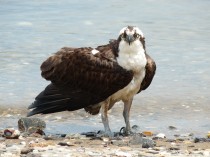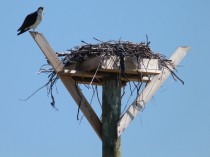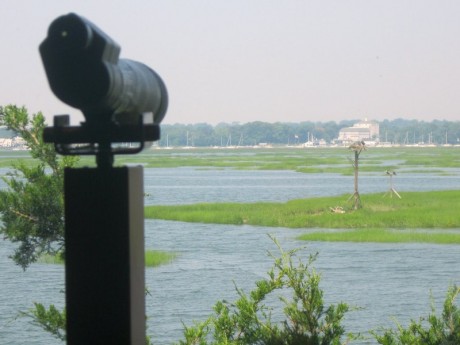Osprey Makes Comeback

At many LISS Stewardship Sites, osprey can be seen flying overhead or perched in tall nesting platforms. These birds of prey are easy to recognize due to their large size and distinctively crooked wings, which can span six feet, but not long ago they were close to extinction in North America. Their prevalence today is a ringing success story.
Osprey exist throughout the world, feeding almost exclusively on fish (hence the alternate name “fish hawk”) and generally migrating south to nest during the winter. But their livelihood in North America was gravely imperiled in the mid-20th century, when pesticide use became rampant in the US. Starting in 1945, farmers began to widely use the pesticide DDT to protect their fields from insects. Little was known then about the environmental impact of spraying such chemicals indiscriminately through wildlife.
Exposure of this chemical devastated the osprey population. Through a process called biomagnification, animals higher up on the food chain face an exponential accumulation of the chemical that has been consumed by each level of wildlife below them. Birds of prey like osprey, bald eagles, and peregrine falcons became less able to absorb calcium and laid eggs with thinner shells that would break before hatching. Raptors typically only lay one to three eggs at a time, so this vulnerability had a sudden and dramatic impact. The species were listed as endangered by the 1970s, and many naturalists feared the extinction of osprey and bald eagles from New England entirely. In 1974 Connecticut’s osprey population was at an all-time low: only nine active nests.
But the modern environmentalist movement was born just in time. Rachel Carson’s classic Silent Spring, published in 1962, questioned the use of chemicals like DDT before understanding their greater ramifications. The large public outcry that followed led to the banning of DDT in 1972, often regarded as the first major success of modern environmentalism.

Osprey have since made an astounding comeback. Their numbers have climbed steadily and dramatically since the 1970s and they are no longer regarded as a threatened species. Thousands of osprey and bald eagles now nest throughout North America—their populations are at near-historic levels. Their tremendous resurgence is a testament to the power of activism even in the bleakest of conditions.
Naturalists have constructed osprey nesting platforms throughout New England at sites where natural nesting areas are sparse, which the birds have used readily. The Audubon Coastal Center at Milford Point seasonally streams a live webcam from inside one of its 18-foot nesting platforms, providing an up-close view of these striking birds as chicks and adults. The public is encouraged to visit the Coastal Center to explore its range of exhibits and programs on the Sound’s wildlife. Birdwatching is particularly exceptional—more than 300 species have been spotted there, and it is recognized by National Audubon Society as an Important Bird Area.
The prevalence of osprey at Stewardship Sites throughout the Sound is a reminder of the importance of being engaged in the conservation of our natural heritage. Each active nest is proof of our power to make lasting change.

Learn More:
- Engage with the Connecticut Audubon Society’s Coastal Center at Milford Point to learn more about osprey and New England’s other birds and wildlife.
- Read more about osprey from Audubon’s species overview or CT DEEP’s fact sheet.